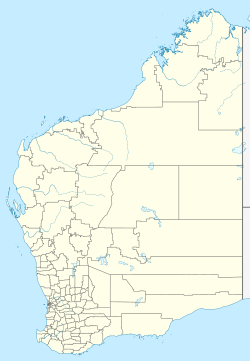Waychinicup National Park
| Waychinicup National Park | |
|---|---|
 Waychinicup Inlet | |
| Location | Great Southern |
| Nearest city | Albany |
| Area | 3,982 ha (9,840 acres)[1] |
| Established | 1990 |
| Governing body | Department of Environment and Conservation |
| www | |
Waychinicup National Park is a in Western Australia (Australia), 404 kilometres (251 mi) southeast of Perth and 65 kilometres (40 mi) east of Albany and extends as far Cheynes Beach near Bremer Bay. Facilities at the park include a camping area and bush toilet near the inlet of the Waychinicup River. [2]
The park offers and array of landscapes from the rugged coast to boulder strewn hilltops. Tree filled deeply incised valleys have fresh water streams flowing through them and are covered in moss covered boulders. The park is bordered by the Southern Ocean to the south, Mount Manypeaks Nature Reserve to the east and agricultural land to the north. The coastline of the park is enclosed between Normans Beach and Cheynes Beach.[3]
Fauna
The park is home to some of the rarest animals in Australia. Some of the species found in the park include Quenda, Ring tailed possums and one of the few mainland populations of Quokkas.[4]
The park forms part of the Two Peoples Bay and Mount Manypeaks Important Bird Area, identified as such by BirdLife International because of its significance in the conservation of several rare and threatened bird species.[5] The critically endangered Noisy Scrub-bird, which was once thought to be extinct, is found within the park; a small population of 14 were translocated from Two Peoples Bay Nature Reserve in 1983, followed by another 16 in 1985. By 1994 it was estimated that 223 male birds had been heard singing in the area.[6]
The Western Bristlebird is another vulnerable species that is found within the park. Most of the birds remaining population is found in Two Peoples Bay Nature Reserve and Waychinicup National Park.[7] Populations of the bird that have been on the decline since the late 19th century has started to stabilise.
References
- ^ "Department of Environment and Conservation 2009–2010 Annual Report". Department of Environment and Conservation. 2010: 48. ISSN 1835-114X.
{{cite journal}}: Cite journal requires|journal=(help) - ^ "Australia's South West - Waychinicup National Park". 2007. Retrieved 2007-06-06.
- ^ "Rainbow Coast - Great Southern Attractions". 2010. Retrieved 2010-11-12.
- ^ "Department of Environment - Waychinicup National Park". 2007. Retrieved 2007-06-06.
- ^ BirdLife International. (2011). Important Bird Areas factsheet: Two Peoples Bay and Mount Manypeaks. Downloaded from http://www.birdlife.org on 2011-11-18.
- ^ "Noisy Scrub-bird (Atrichornis clamosus) Recovery Plan". 2007. Retrieved 2007-06-06.
- ^ "Dasyornis longirostris — Western Bristlebird". 2010. Retrieved 2007-06-06.

